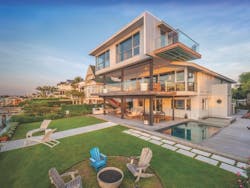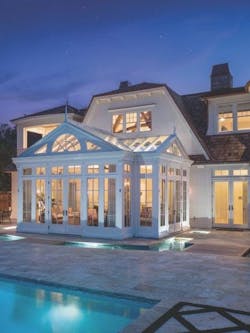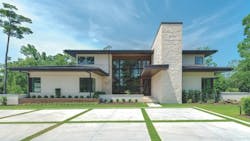Q + A: The Luxury of Time
Mark Batson, owner of Tongue & Groove Design + Build, in Wilmington, N.C., grew up on a fishing boat, and those ties to coastal North Carolina continue to inform his work and decision-making as a builder. Named National Custom Home Builder of the Year 2020 by the National Association of Home Builders, he credits his leadership philosophy, which hinges on humility and gratitude, as the reason for that success. Batson spoke with Custom Builder about the award and how an integrated design/build process suits his luxury clientele.
How did you enter the residential construction industry?
Mark: I come from a family of fishermen, grew up on fishing boats, and we did commercial fishing and then charter fishing in the summer. Working with your family in a small business is sort of like working on a farm; you have to learn how to work with your hands.
When I went to college, I had to pay my way through school. To do that, I did small renovation projects for people, like finishing a bonus room or sanding and finishing hardwood floors, or painting walls, or whatever came up.
Then, when I graduated from college, I got a job selling building materials. I met with builders around town and realized, “I can do this.” That was back in 2000. And so my wife and I bought a lot and built our own house.
It wasn’t something we could afford to pay other people to do everything on, and so I did a lot of the work myself.
And then my brother and I got creative and made undersea scenes for the balconies out of a stainless steel rod, bending it into the shape of whales and dolphins. And there were multiple other things around the house we did that were also aesthetically interesting and different. Two of my friends came through the house and said, “Hey, we think you’re creative. You’ve done a great job here. And we’d love for you to build our house.”
You design and build high-end custom homes for your clients. What does the term “luxury home” mean to you?
Mark: You know, we build these beautiful structures, but they’re just things. They’re simply possessions. The whole objective is [to enable] families to spend more time together. That’s all it’s about.
What are the things that free up your time the most?
Mark: Think about that ... There are little things, all of the conveniences ... All of the things you don’t have to do, that you don’t need to do in order to just be. So, for a luxury home, for example, what makes it luxury is that everything about it is high quality, and everything about it is well thought out. And the most priceless thing in the world, the one thing wealthy people cannot buy, is time.
How do you go about identifying those conveniences for a client?
Mark: The way you do that is not by telling clients, but showing them. Whenever I meet with clients, we don’t do a presentation, we do a consultation. We get to know the client and then we begin the questioning phase. We need to know what your pain points are and what your pleasure points are, and once we figure those out, then we can apply a solution specifically for that client to solve that pain or [enhance] that pleasure.
It’s all about rapport with the client and understanding what they really want. And once you have that, and graphically show them how you’re going to solve their problem, then you’re off to a good start.
That’s during the schematic design phase, the programming phase of design. … Once we get on the same page with a snapshot of what the client is after, then we can attack design in earnest and really take a lot of the pressure off them. We’ll take it from there all the way through. We can take it all the way through furniture with just our initial programming phase, generally.
Have you been able to find any solutions as a design/build firm for the disrupted supply chains and other hurdles during the past year?
Mark: Our projects are usually multiyear and we have extended lead times for everything we do to begin with. With integrated project delivery and design/build the way I do it, when we start the project, we’ve [purchase ordered] the entire project all of the way through. That’s the advantage of designing everything up front and estimating everything up front. So the way we’ve overcome [the hurdles] is by planning.
I’ve heard from other builders that over-communication with everyone involved in a project has been a saving grace this past year.
That’s exactly right. And that’s one of the keys to any successful project: communication; knowing what to say and when to say it ... starting with your gratitudes—making sure everyone knows you’re grateful for everything you’re doing at all times.
I had a product show up that we’d ordered three months ago. It was supposed to arrive in two weeks, but it didn’t come and ended up being delayed. … It just got delivered today and it was such a relief. And you know what I did? I picked up the phone and called the regional rep, who we’ve been hounding for weeks and I told him, “I want you to know this is a good call. I just want to say I’m so thankful that the product showed up today. Everybody’s got smiles on their faces. We’re all relieved. And we really appreciate you a lot.” And he said, “Mark, I’ve cleared my schedule for the next week and I’m going to be on the phone just for you guys to make sure you can get this installed properly. I’m on-call for your guys, and I’m all about helping you out. I really appreciate the call. It means a lot to me.”
Those kinds of calls are critical. It’s not about the money. It’s not about anything other than your interpersonal communication with other people that makes a big difference. People will walk through a fire for you if they think you care. Apply that throughout, whether it’s with a sub, a vendor, or an employee.
You construct homes near or in flood zones. Can you tell us more about the role resilient construction plays in your process?
Mark: Everything we do is pretty much waterfront. And any kind of structure that’s waterfront is subject to the same conditions as a ship at sea: wind, rain, salt spray, sun. I grew up on boats, so I lived that. And so I think about houses like I do a boat: How is this thing going to function in a storm? How’s it going to function day to day?
And then, from a practical standpoint, not only is it storm-resistant, but when you’re thinking about living in the house and for it to be convenient, what would be the best case scenario? I always think I want to be able to scrub it down and hose it off just like I would a boat. So the materials we use are the same ones you’d find on a boat. It’s real simple, but it’s really durable.
When I’m designing a house, especially on the water, I incorporate a lot of nautical details: porthole windows, curves, mahogany, and teak, things like that. We came up with a term—Yacht Modern—to describe some of these modern designs, and I had it trademarked.
What do you think puts you ahead of other builders and ultimately makes you deserving of the title Custom Home Builder of the Year?
Mark: The most important thing for anybody to be at the top of their trade is to acknowledge the people around you. The team-building I’ve done, and the accumulation of our knowledge together and our drive together, is the true reason for our success.
You come up with a vision, but that’s just the beginning. It’s everyone else in the background that [actually] makes it happen. It’s an honor to be the face of it. It really is.


